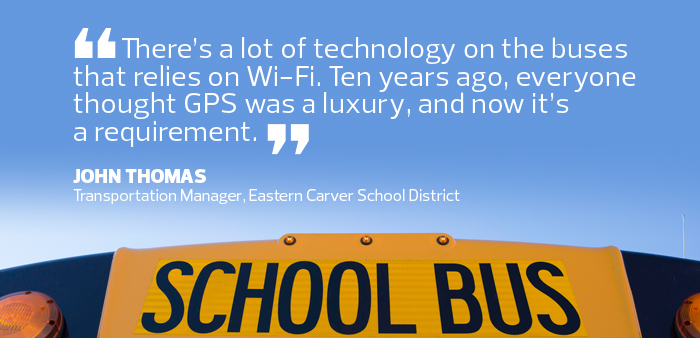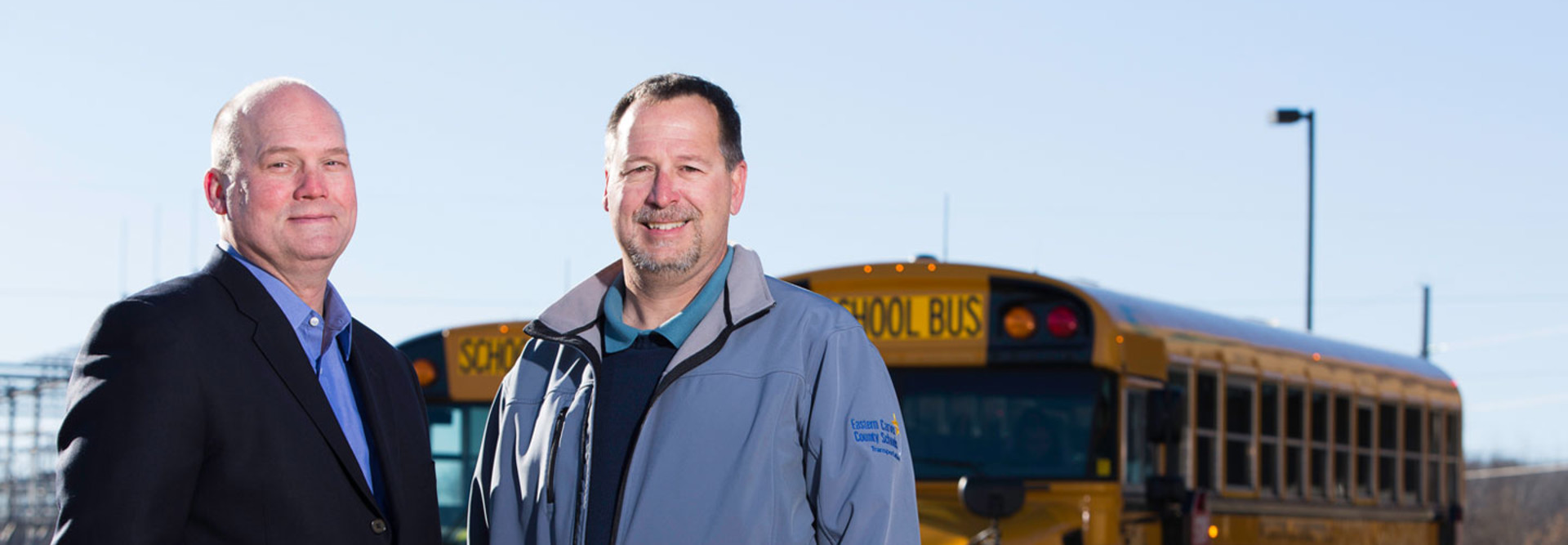Schools Expand Wi-Fi Beyond the Classroom
Students in Minnesota who live nearly an hour from a big city log plenty of time on buses, whether they’re traveling to away games with the hockey team or going on field trips with the science club.
Eastern Carver County Schools in Chaska, Minn., wanted to make those long bus rides more productive and help teachers put that otherwise wasted time to good use. But to do that they needed to put the internet on wheels.
In the summer of 2013, the district began installing Cradlepoint access points on 20 of the buses it uses for field trips. The APs connect through a Verizon private network gateway to a Cisco Systems router on the school’s network. The pilot was so successful that in spring 2014, Eastern Carver outfitted all 112 of the buses that ferry some 11,000 students to and from school each day.
Like Eastern Carver, many schools across the U.S. are extending their wireless networks to places such as school buses or sports facilities to give students expanded opportunities to connect and learn.
“I’ve seen schools put Wi-Fi in lobbies, football fields, theaters, gymnasiums and any other part of what’s considered school property,” says Zeus Kerravala, founder and principal analyst at ZK Research. “The most important reason for it is being able to expand learning capabilities outside the traditional classroom.”
Bus Wi-Fi Expands the Classroom's Reach
Outfitting buses with web access was popular with students, teachers and bus drivers at Eastern Carver, says Transportation Manager John Thomas. And they quickly discovered an unanticipated but very welcome bonus: When you provide internet on a bus, student behavior improves dramatically.
“The kids were quiet and well behaved,” Thomas says. “They were able to keep up with their homework instead of harassing each other and goofing around for four hours. We hadn’t even thought about that. Not only was the network achieving its educational purpose, but the students were calmer because they had something to do.”
The plan to outfit buses with Wi-Fi dovetailed nicely with the district’s plan to roll out one-to-one computing, says IS Administrator Craig Larsen. Now all students from grades three through 12 have a Chromebook they can use in class, on the bus or at home.
Eastern Carver’s Wi-Fi program also had the benefit of extending the classroom to the world outside, adds Larsen.

“We live in an area with a lot of agricultural projects,” he says. “Teachers can take students into the fields, where they can identify plants, perform lab experiments and upload their data from their tablets to the bus instead of waiting until they get back to school.”
Tech Initiatives Require Community Support
The hardest part was convincing the community that giving students mobile internet access was a good thing, Thomas says.
“We got a tremendous amount of support from people in one direction and a tremendous amount of cynicism from the other,” he says.
“Traditionalists were saying, ‘Why are you offering them Wi-Fi when they should be reading a book or looking out the windows?’"
Fortunately for district students and faculty, the modernists won. And while Eastern Carver may have been a bit of a trailblazer at the time, every district should consider following its lead, Thomas adds.
“There’s a lot of technology on the buses that relies on Wi-Fi. Ten years ago, everyone thought GPS was a luxury, and now it’s a requirement. Buses will need to be able to quickly talk to the internet.”
Mobile Access Helps to Close the Divide
Since Eastern Carver initiated its mobile internet program, other school districts across the country have joined them. In Coachella Valley Unified School District in California, the second poorest school district in the U.S., only 60 percent of families have internet access. So, in 2014, then-Superintendent Darryl Adams decided to bring the internet to the community by installing Cradlepoint APs in 100 school buses.
Since implementing mobile Wi-Fi, the district’s high school graduation rates have risen from 70 to 80 percent.
In addition to serving nearly 19,000 students, the district parks its buses in the most disadvantaged neighborhoods during nonschool hours, so that their solar-powered routers can provide internet access to students at home.
“In the 21st century, if you don’t have access to information, you’re going to be at a disadvantage,” Adams told educational publication THE Journal. “Access denied is education denied.”
Strong Wi-Fi Must Become Before 1:1 Tech
Eufaula, Ala., (population 13,000) is a tiny town with big dreams.
In 2016, Eufaula City Schools decided to adopt a one-to-one computing model. The problem? The rural district’s aging wireless network was so unreliable that teachers had stopped using it, says Todd Watkins, who had just been hired as its new director of technology and innovation. There was no way it could handle more than 1,000 new devices. And the district didn’t have room in its budget for tech upgrades.
But what Eufaula did have was an almost-finished $3.2 million indoor sports facility. That facility has a weight room with tablet PCs mounted to every machine, where coaches can display instructions on how to do lifts and athletes can record weight and reps for each set.
It has IoT-enabled fountains that measure how much water every athlete drinks, so coaches can make sure players stay hydrated. It has a big screen that displays everyone’s stats, so students can gamify their workouts by competing against each other.
All of that requires a robust wireless network. For Watkins, that presented an opportunity. He asked the district’s technology partner, Extreme Networks, to include four nearby classrooms in the facility’s network, which Watkins could use to compare against the district’s existing wireless infrastructure.
The new network was so capable that teachers began to hold classes at the sports facility, and Watkins used the result of the network comparisons to successfully argue that the entire district’s network needed to be refreshed.

A year later, all kindergarten through second-grade students in Eufaula have tablets in their classrooms, while each student in grades three through 12 has a Lenovo N23 or Yoga Chromebook.
The district network features Extreme’s AP 3935 access points, X480 switches, and WS-C35 wireless controllers. Even better, Eufaula managed to secure most of the funding for the $420,000 districtwide upgrade from the federal E-rate program and Alabama’s Wireless Infrastructure Renovation for Education (WIRED) Act.
And Eufaula is not yet done innovating. The football coaches plan to outfit each athlete with a wearable device to track their workouts and vital signs. Eufaula’s high school has launched a drone training program that will enable students to graduate with their FAA pilot’s license, says Watkins.
None of that would be possible without the right network infrastructure in place, says Watkins.
“Schools want every student to have a device and every teacher to use technology in the classroom, but they need to start with the network first,” he says.









